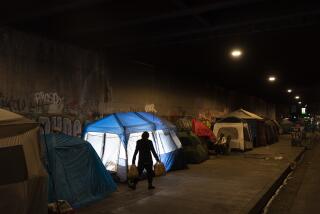Young, Black, in Critical Condition
- Share via
BERKELEY — Young black males in America’s inner cities are an endangered species, constantly threatened with physical, psychological or social annihilation. They have been miseducated by the educational system, mishandled by the criminal justice system, mislabeled by the mental health system and mistreated by the social welfare system.
Their inner-city neighborhoods have become “welfare plantations,” their families dependent on government benefits, isolated from the mainstream and unable to escape from the ghetto. They are rejects of our affluent society and misfits in their own communities. Since the march on Washington in 1963, the status of black males, ages 15-24, has deteriorated by most significant social and economic measures. As conditions have worsened, young blacks have grown increasingly angry and alienated from the dominant culture. It is time for policy-makers to ask: What has happened to these youth? Why? And what can be done to address their problems?
Six major social indicators reveal what has happened in the past 25 years.
First, while overall school dropout rates of black youths have improved in recent years, rates for inner-city black males have increased to levels of 40%-50%. In 1980, one of five black male teen-agers was unable to read at the fourth-grade level, thus unqualified for most entry-level jobs, apprenticeship programs or military service.
Second, unemployment rates for these inner-city youths also range from 40%-60%, three times higher than in 1960. Employment rates for black males 16-19 dropped from 42% in 1960 to 36% in 1980. In 1984 nearly half the black youths, 16-24, had never held a regular job.
Third, crime and delinquency are rampant in the inner cities, with black youths accounting for close to one-third of juvenile arrests for felony offenses, yet they represent only one-fifth of the youth population. Most victims are also black--meaning both victimizers and victims are poor and black.
Fourth, drug abuse is endemic in many inner-city neighborhoods, transformed into battlegrounds over the sale and distribution of cocaine and heroin. The drug industry has not only created lucrative jobs for unemployed teen-agers, it has also created a violent life style and a new health menace for black males. Heterosexual intravenous drug users account for more than one-third of the AIDS cases among black males, who now represent one-fourth of all male cases.
Fifth, homicide is the leading cause of death among young black males. A young black male has a 1 in 21 chance of being murdered before he reaches age 21, primarily by a gun fired by another black male. Young black males are six times as likely as young white males to be victims of homicide.
Sixth, suicide is the third leading cause of death for young black males. Since 1960, suicide rates have nearly tripled for young black males; while suicide among whites increases with age, it is a peculiarly youthful phenomenon among blacks.
The “new morbidity,” a term coined to describe these unacceptably high youth death rates caused by social rather than biological factors, is particularly applicable to young black males.
Three major factors explain how these problems developed and why they have worsened in less than three decades. First, structural and technological changes in the society have shifted the economy from an agricultural and manufacturing base to a service and high-technology base, requiring a more skilled and educated labor force. As new jobs have moved from city to suburbs and from East to West, urban black youths have had neither the skills nor the mobility to qualify. Without employment opportunities, they have developed an underground economy in drugs, stolen goods and gambling.
A second factor is the growth of black female-headed families--from 22% in 1960 to 42% in 1983. This increase parallels the increase in unemployment among black males and is a major cause of lowered marriage rates in this group. Those who claim that welfare programs have encouraged higher teen-age birth rates are wrong on two counts; black teen-age birth rates are now lower than they were in 1960, but out-of-wedlock birth rates are generally higher in states with the lowest welfare payments and the highest rates of male unemployment.
Two of every three children in black female-headed households are poor; they live in substandard housing, attend inferior schools, lack access to adequate health care and are exposed at early ages to drugs, crime and violence.
The third factor is a conservative political climate that fostered a backlash to civil rights advances and affirmative action programs in employment and education. The national debate has shifted from an active emphasis on policies of prevention and early intervention to a reactive emphasis on policies of retrenchment and rehabilitation.
The combination of factors has resulted in an escalating cycle of disadvantage, dysfunction and despair. Efforts to reverse these trends, with few exceptions such as Head Start and the Job Corps, have failed because they have not been carefully conceptualized, planned or implemented. Fragmented policies and piecemeal programs have failed to recognize the interrelationship of the problems and the need for a well-coordinated network of services.
Then what to do? We can begin by developing a set of family-assistance policies to improve income supports for poor families and children, to increase the self-sufficiency of welfare recipients through education and employment training programs and to provide adequate social services, health care and housing to strengthen family functioning.
The educational system must be radically restructured to meet the needs of black youth. Priority areas of change include: increased funding for early childhood programs, compensatory education and improved vocational education; improvement in the recruitment and training of teachers, with a special focus on increasing the pool of minority teachers, and implementing dropout prevention programs. In 1987, the Committee for Educational Development reported that for each dollar spent to prevent educational failure, $4.75 would be saved in future costs for remedial education, welfare and crime.
Employment and training efforts should concentrate on the hard-core unemployed and unskilled youth through such programs as the Job Corps, the Youth Conservation Corps and the Private Industry Council school-to-work transition programs. Advocates of the Job Corps pointed out that each dollar spent on a training slot will return $1.46 in taxes within two years from a youth who would otherwise be unemployed. If the $15,000 cost of training 2.5 youths per year is compared to the $22,000 annual cost of incarcerating one youth, the advantages are obvious.
To reduce rates of homicide and violent crime, a strong and enforceable gun-control policy must be adopted at all levels of government to prevent easy access to weapons. Drug education and prevention programs should be linked to AIDS education and prevention through community-based clinics. Comprehensive health clinics should be established in the junior and senior high schools to provide a wide range of services, including family planning, counseling and crisis intervention.
Solving these problems is no longer a matter of conscience or choice. It is a demographic imperative and a public-policy priority. Black youth will constitute about one-fifth of the labor force in the early 21st Century; the nation’s productivity will depend on their ability and employability. If this society does not invest in preventive policies and programs, it will allocate far more resources to maintain punitive programs--to build more prisons, to treat more addicts, to battle unacceptable levels of community violence. Finally, the growing urban underclass is a threat to the political and social stability of this nation.
Government programs alone are not sufficient. Cooperative efforts should be developed among all the major social institutions--businesses, professional organizations, churches and civic organizations.
If black youths are given real opportunities for education, if they are provided with meaningful jobs, if they have adequate income to care for their families, if they have hope for future mobility, then they will contribute their fair share to the larger community. We have the knowledge, technology and the resources to improve life chances for young black males. What we need is the compassion, commitment and consensus to create a human environment for all youth in this country.
More to Read
Sign up for Essential California
The most important California stories and recommendations in your inbox every morning.
You may occasionally receive promotional content from the Los Angeles Times.










